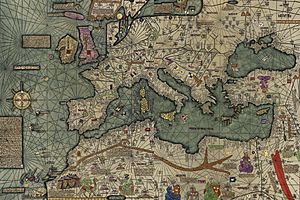Mediterranean Lingua Franca facts for kids
Quick facts for kids Mediterranean Lingua Franca |
|
|---|---|
| sabir | |
| Region | Mediterranean Basin (esp. Morocco, Algeria, Tunisia, Libya, Lebanon, Greece, Cyprus) |
| Extinct | 19th century |
| Language family |
Pidgin, Romance based
|
| Official status | |
| Official language in | none |
| Linguasphere | 51-AAB-c |
The Mediterranean Lingua Franca, also called Sabir, was a special "contact language." Think of it as a bridge language. It helped people from different countries talk to each other. This language was used in the Mediterranean Basin from the 11th to the 19th centuries. It was mainly used for trade and talking between different groups.
Contents
What Does Lingua Franca Mean?
The name Lingua Franca literally means "Frankish language" in old Latin. At first, it described the language used for trade in the Eastern Mediterranean Sea. The term "Franks" was used for all Western Europeans back then. Later, lingua franca became a general term for any "bridge language."
Its other name in the Mediterranean area was Sabir. This word is similar to words like saber in Spanish, sapere in Italian, and savoir in French. All these words mean "to know."
How Did It Start?
The Lingua Franca began mostly from languages spoken in Northern Italy. These included Venetian and Genoese. In the western Mediterranean, it also got words from Occitano-Romance languages like Catalan and Occitan.
Over time, more Spanish and Portuguese words were added. This was especially true along the Barbary Coast, which is now called the Maghreb. The Lingua Franca also borrowed words from Berber, Turkish, French, Greek, and Arabic.
The way the language was put together, its grammar, took parts from many of these languages. For example, verbs often used their basic "infinitive" form. Most of its words came from Italian and Spanish.
A Brief History
This mixed language was very important for business and talking between different countries. It was also used by slaves, pirates, and Europeans living in Algiers long ago. The first people to use it were traders from Genoa and Venice. They started using it in their trading posts in the eastern Mediterranean after the year 1000.
As the use of Lingua Franca spread in the Mediterranean, different versions appeared. In the Middle East, more Italian and Provençal words were used. In the Maghreb, words from Spanish and Portuguese were more common. Later, in the 19th century, France became powerful in the Maghreb. The Lingua Franca spoken in Algeria then took on many French words. People there sometimes thought they were speaking French! Lingua Franca also influenced other languages, like Eritrean Pidgin Italian.
Some experts say Lingua Franca was a "pidgin" language. A pidgin is a simplified language that develops when groups of people who don't share a common language need to communicate. Other experts think it was more like a simplified version of Italian.
A scholar named Hugo Schuchardt was the first to study Lingua Franca carefully. He believed that many pidgin languages around the world came from Lingua Franca. When Portuguese sailors explored new lands, they tried to talk to local people using a mix of Portuguese and Lingua Franca. Later, when English or French ships arrived, their crews learned this "broken Portuguese." Over time, the words changed to English or French, but the basic way of speaking remained similar.
This idea helps explain why many European-based pidgins and creole languages are alike. Languages like Tok Pisin and Papiamento have words similar to sabir for 'to know' and piquenho for 'children'.
Lingua Franca has left small traces in modern Algerian slang and a secret language called Polari. It even influenced some place names, like Cape Guardafui. This name literally means "Cape Look and Escape" in Lingua Franca and old Italian.
Why Is There Debate?
Many things about Lingua Franca are still discussed by experts. This is because it was mostly a spoken language. There are some writings about it and examples in old books, but not many real recordings of people using it. This also shows that the language was always changing.
Experts still debate what type of language it was. They also discuss where the term "lingua franca" really came from.
Even though it's officially called a pidgin, some scholars disagree. They think it might have been a simplified Italian or a "koiné language." A koiné is a common language that develops from different dialects.
There are also different ideas about what "lingua franca" means. Some say it means "free language," perhaps for free trade. Others think it came from Arabic, meaning "Latin language" or "trade language." It has also been thought to mean "Venetian" or "western language," or simply "French language."
See also
 In Spanish: Sabir para niños
In Spanish: Sabir para niños
- African Romance
- Mozarabic language
- Lingua Franca Nova


